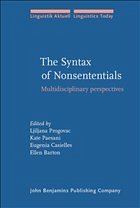Nicht lieferbar

The Syntax of Nonsententials
Multidisciplinary perspectives
Versandkostenfrei!
Nicht lieferbar
Main description:This volume brings the data that many in formal linguistics have dismissed as peripheral straight into the core of syntactic theory. By bringing together experts from syntax, semantics, pragmatics, philosophy of language, language acquisition, aphasia, and pidgin and creole studies, the volume makes a multidisciplinary case for the existence of nonsententials, which are analyzed in various chapters as root phrases and small clauses (Me; Me First!; Him worry?!; Class in session), and whose distinguishing property is the absence of Tense, and, with it, any syntactic phenomena th...
Main description:
This volume brings the data that many in formal linguistics have dismissed as peripheral straight into the core of syntactic theory. By bringing together experts from syntax, semantics, pragmatics, philosophy of language, language acquisition, aphasia, and pidgin and creole studies, the volume makes a multidisciplinary case for the existence of nonsententials, which are analyzed in various chapters as root phrases and small clauses (Me; Me First!; Him worry?!; Class in session), and whose distinguishing property is the absence of Tense, and, with it, any syntactic phenomena that rely on Tense, including structural Nominative Case. Arguably, the lack of Tense specification is also responsible for the dearth of indicative interpretations among nonsententials, as well as for their heavy reliance on pragmatic context. So pervasive is nonsentential speech across all groups, including normal adult speech, that a case can be made that continuity of grammar lies in nonsentential, rather than sentential speech.
Table of contents:
- Preface
- Introduction
- 1. Toward a nonsentential analysis in generative grammar
- 2. The syntax of nonsententials
- 3. 'Small structures'
- 4. Neither fragments nor ellipsis
- 5. Big questions, small answers
- 6. Extending the nonsentential analysis
- 7. The narrowing acquisition path
- 8. Nonsententials in second language acquisition
- 9. How language adapts to the brain
- 10. Nonsententials and agrammatism
- 11. Reduced syntax in (prototypical) pidgins
- 12. Copula variation in Guyanese Creole and AAVE
- Epilogue
- Index
This volume brings the data that many in formal linguistics have dismissed as peripheral straight into the core of syntactic theory. By bringing together experts from syntax, semantics, pragmatics, philosophy of language, language acquisition, aphasia, and pidgin and creole studies, the volume makes a multidisciplinary case for the existence of nonsententials, which are analyzed in various chapters as root phrases and small clauses (Me; Me First!; Him worry?!; Class in session), and whose distinguishing property is the absence of Tense, and, with it, any syntactic phenomena that rely on Tense, including structural Nominative Case. Arguably, the lack of Tense specification is also responsible for the dearth of indicative interpretations among nonsententials, as well as for their heavy reliance on pragmatic context. So pervasive is nonsentential speech across all groups, including normal adult speech, that a case can be made that continuity of grammar lies in nonsentential, rather than sentential speech.
Table of contents:
- Preface
- Introduction
- 1. Toward a nonsentential analysis in generative grammar
- 2. The syntax of nonsententials
- 3. 'Small structures'
- 4. Neither fragments nor ellipsis
- 5. Big questions, small answers
- 6. Extending the nonsentential analysis
- 7. The narrowing acquisition path
- 8. Nonsententials in second language acquisition
- 9. How language adapts to the brain
- 10. Nonsententials and agrammatism
- 11. Reduced syntax in (prototypical) pidgins
- 12. Copula variation in Guyanese Creole and AAVE
- Epilogue
- Index




